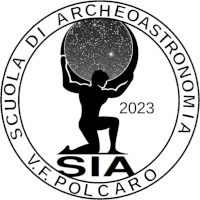Speaker
Description
Poniamo tre domande iniziali:
- Come si trova il meridiano?
- Che cosa succede sul meridiano?
- Dove osservare un meridiano?
Facciamo attenzione al linguaggio: la parola “meridiano” rimanda al meridiano che può essere materializzato da una linea in terra, ad una serie di cerchi massimi sulla sfera della Terra, ad un piano sopra l’orizzonte che contiene il meridiano celeste locale.
Facciamo attenzione ai livelli di approssimazione.
I Cerchi Indù sono uno degli strumenti possibili per tracciare il meridiano locale con il Sole: la linea del meridiano locale, linea Nord-Sud, può essere tracciata come linea di simmetria tra le ombre di uno gnomone segnate in terra nella mattina e nel pomeriggio. Il metodo detto dei Cerchi di uguale altezza, o dei Cerchi Indù, è basato su una serie di circonferenze concentriche, con centro nel piede dello gnomone verticale, sulle quali viene segnato l’estremo dell’ombra a diverse ore, prima e dopo il mezzogiorno vero
locale: le coppie di punti dell’estremo dell’ombra che si trovano su una stessa circonferenza, indicano che due volte in una giornata il Sole raggiunge la stessa altezza sull’orizzonte prima e dopo la sua culminazione sul meridiano locale (e in prima approssimazione alla stessa distanza di tempo dal mezzogiorno).
Dall’unione di tali coppie di punti si ha una serie di corde dei cerchi tra loro parallele e parallele alla linea equinoziale, linea Est-Ovest: dall’unione dei loro punti medi, si ottiene la direzione cercata.
Gli strumenti che servono sono quindi un compasso o una corda per tracciare le circonferenze su un terreno pianeggiante e un bastone che serve da gnomone. E’ necessario un periodo di tempo di registrazione prima e dopo il mezzogiorno solare. Più registrazioni si effettuano e maggiore è la precisione ottenuta.
La lezione sarà tenuta in italiano
Abstract:
We ask three initial questions:
- How is the meridian located?
- What happens on the meridian?
- Where to observe a meridian?
Let's pay attention to the language: the word "meridian"; refers to the meridian which can be materialized by a line on the ground, to a series of great circles on the sphere of the Earth, to a plane above the horizon which contains the local celestial meridian.
Pay attention to the levels of approximation.
The Hindu Circles are one of the possible tools for tracing the local meridian with the Sun: the line of the local meridian, the North-South line, can be traced as a line of symmetry between the shadows of a gnomon marked on the ground in the morning and in the afternoon. The method known as Circles of Equal Height, or Hindu Circles, is
based on a series of concentric circles, with the center at the foot of the vertical gnomon, on which the extreme of the shadow is marked at different times, before and after noon true local: the pairs of points at the end of the shadow that are on the same circumference indicate that twice in one day the Sun reaches the same height above
the horizon before and after its culmination on the local meridian (and before approximation to the same time distance from noon). From the union of these pairs of points there is a series of chords of the circles parallel to each other and parallel to the equinoctial line, East-West line: from the union of their midpoints, the desired direction is
obtained.
The tools needed are therefore a compass or a rope to trace the circumferences on a flat ground and a stick that serves as a gnomon. A period of recording time is required before and after solar noon. The more registrations you make, the greater the accuracy you get.
- The lesson will be held in italian language

